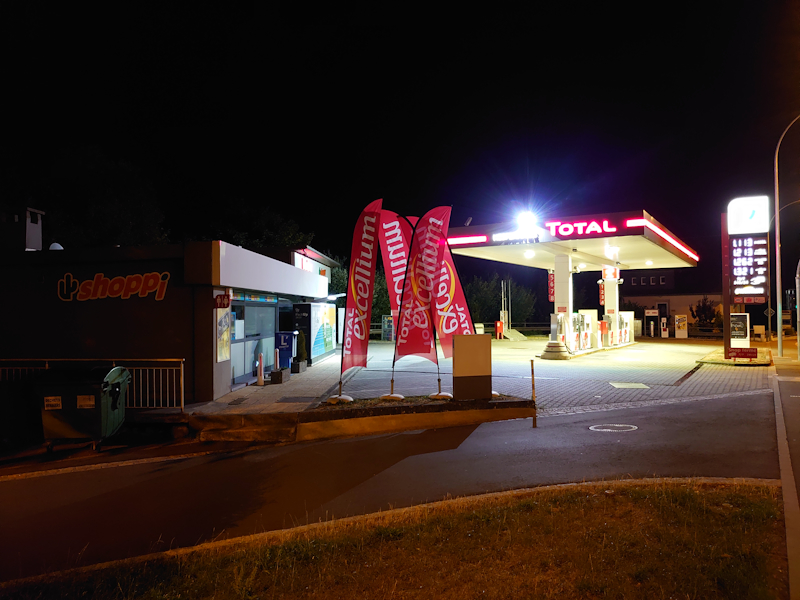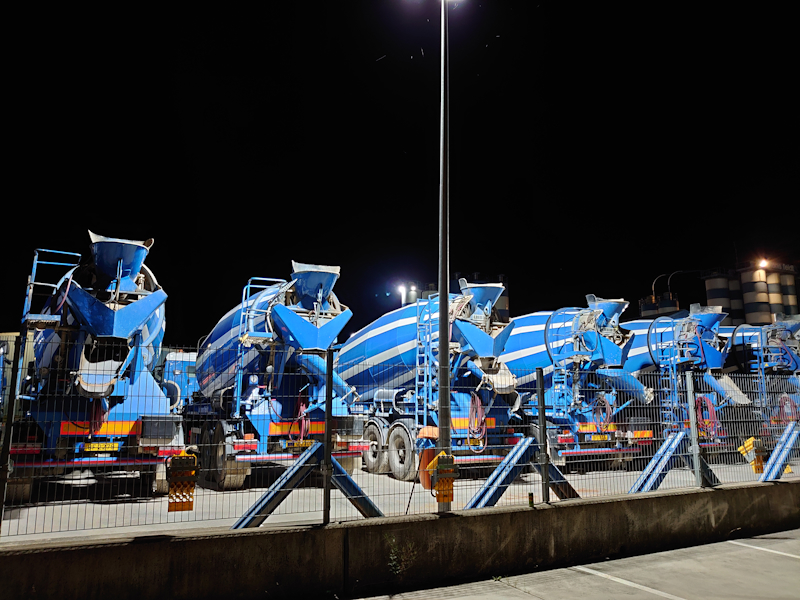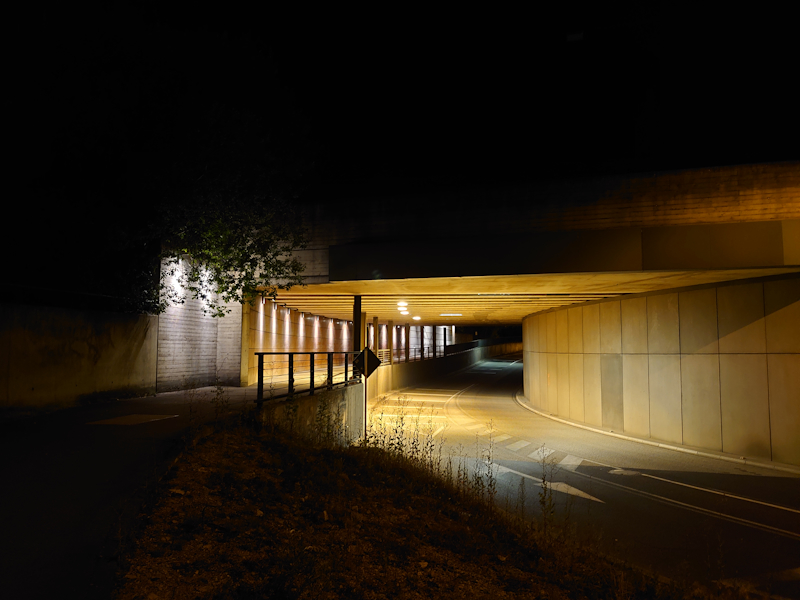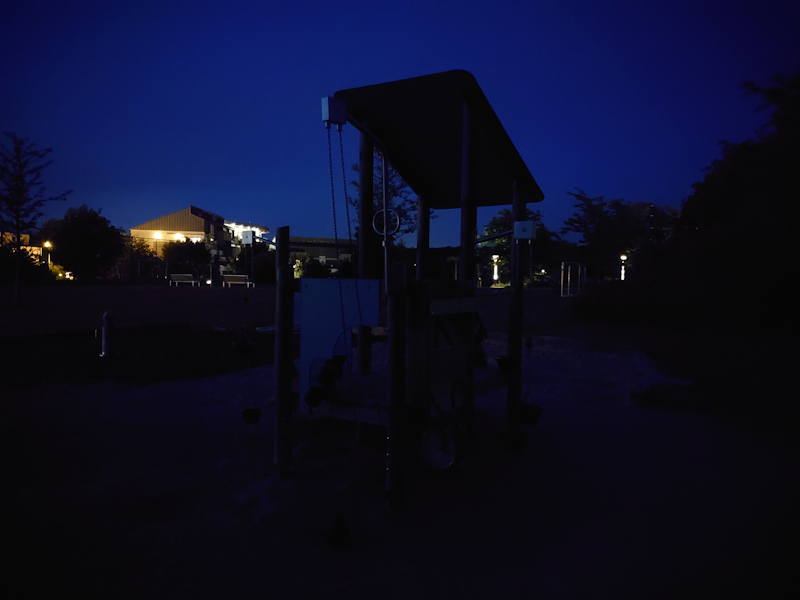The Sony Xperia 1 Review: A 21:9 Take of the World
by Andrei Frumusanu on July 26, 2019 8:00 AM EST- Posted in
- Mobile
- Sony
- Smartphones
- Xperia 1
Camera - Low Light Evaluation

[ Xperia 1 ] - [ S10+ (E) ] - [ S10+ (S) ]
[ P30 Pro ] - [ G8 ] - [ Pixel 3 ] - [ iPhone XS ]
In the first shot here, it’s a typical situation where a camera which only has a certain level of limited dynamic range, has to choose between exposing between the darker parts or the highlights of the scene. The Xperia 1 chose to go for exposing more for the shadows which has the adverse effect of really blowing out the highlights.
Unfortunately Sony here can’t compete with other phones which just have better and wider dynamic range processing – for example Apple’s iPhone XS manages a significantly better result.
The phone is already bottom barrel as it is, however against phones with dedicated night modes it’s no longer much of a competition.
On the wide-angle the dynamic range is still bad, however Sony’s detail preservation as well as noise reduction is top notch, while other phones end up with quite blurred out and ugly noise reduction.

[ Xperia 1 ] - [ S10+ (E) ] - [ S10+ (S) ]
[ P30 Pro ] - [ G8 ] - [ Pixel 3 ] - [ iPhone XS ]
In more artificially lit scenarios such as this one, the composition differences between the phones are relatively small. The biggest difference remains detail, and notice how the Xperia manages to preserve the dirt on the foreground wall.
The wide angle continues to show a dynamic range weakness and it blows out highlights too much.

[ Xperia 1 ] - [ S10+ (E) ] - [ S10+ (S) ]
[ P30 Pro ] - [ G8 ] - [ Pixel 3 ] - [ iPhone XS ]
This scene was a disaster for the Xperia 1 as the stabilisation didn’t manage to get a clear shot and there’s lots of blurring due to longer exposures both on the main and wide angle. It’s a pretty bad result.

[ Xperia 1 ] - [ S10+ (E) ] - [ S10+ (S) ]
[ P30 Pro ] - [ G8 ] - [ Pixel 3 ] - [ iPhone XS ]
Here we also see the phone struggling with dynamic range and it’s just not able to get sufficient light into the sensor.

[ Xperia 1 ] - [ S10+ (E) ] - [ S10+ (S) ]
[ P30 Pro ][ G8 ] - [ Pixel 3 ] - [ iPhone XS ]
In dim indoor light, the phone still struggles to get much light in, so while details are alright, the exposure isn’t sufficient. The competition’s night modes are just way ahead.

[ Xperia 1 ] - [ S10+ (E) ] - [ S10+ (S) ]
[ P30 Pro ] - [ G8 ] - [ Pixel 3 ] - [ iPhone XS ]
Finally while in extreme low light, even though goes into a special mode, it seems to be all that this does is capture longer exposures, and there’s not too much in way of computational photography.
Low-light Camera Conclusion
While the Xperia 1 has good noise reduction and detail preservation, its lack of dynamic range is extremely evident in low light as it just can’t deal with many scenarios as well as the competition can. The phone actually performs worse than the iPhone XS which is a bad place to be at, as it means that the device definitely can’t keep up with other Android devices which have developed their computational photography capabilities.










75 Comments
View All Comments
Samus - Saturday, July 27, 2019 - link
So this is going to need a custom ROM to get proper 4K rendering across applications? How the hell is a 4K screen useful if the only thing it shows at 4K are photos?Lord of the Bored - Saturday, July 27, 2019 - link
"the included headphones are 3.5mm"No standard headphone port, includes standard headphones.
I ... I can't make fun of this. It is too easy, I'd feel bad.
Cliff34 - Saturday, July 27, 2019 - link
Given that Sony also makes the camera, it will make sense or a stronger marketing strategy if the phone's strong suit is the camera.Hopefully, the next model the smart phone team can work w the camera team to integrate in a way that blows away the competition.
Having a big screen and a small battery is a hard sale. Plus the steep price Tag.
FunBunny2 - Saturday, July 27, 2019 - link
"Given that Sony also makes the camera"this appears to be a case of the cobbler's kids going barefoot. aren't most high end phone cameras sourced from Sony?
5j3rul3 - Saturday, July 27, 2019 - link
So where's the test results of Xperia 1's Loudspeakers in the article?nandnandnand - Saturday, July 27, 2019 - link
"While the panel is indeed 4K"3840 x 1644 = 76% of 4K UHD
s.yu - Sunday, July 28, 2019 - link
The detail retention surprised me. There's clear evidence of heavy sharpening and strange artifacts in the clouds and/or shadows, but yes, some of the increase in detail retention can't be explained by mere sharpening.The results here are better than at GSMA, maybe it's sample variation, but the artifacts are quite often disturbing, like leaves that look munched up by bugs. Apart from crushed blacks, the Pixel's output still seems the best, since it avoids the artifacts, and Apple's SmartHDR also balances between noise retention, artifact generation and detail retention. For example the shadow cast by the tree onto the street(scene 3), there are still tiles in that shadow, yet only the Pixel and XS could recover the tiles with texture in a way that's more or less consistent with the tiles around it under sunlight, while Sony left a smear there and Huawei's texture still seems aggregated and fake. Also in the indoor shot Sony failed in several places regarding texture, it smeared fibers and wood. Sony seems to have gone too far leaving artifacts everywhere.
The sharpness of the UWA is clearly because of the uncorrected barrel distortion, it's half a fisheye which is much easier to correct CA for while the others are largely rectilinear, but the P30P has a narrower FoV, which also makes it easier to correct. The fact that the S10+ is as wide as the Xperia yet as corrected and as sharp as the P30P makes it the better UWA.
s.yu - Sunday, July 28, 2019 - link
At night I believe metering is still a significant issue, devices/instances that expose to the right get much better results overall...and I believe the P30P fakes UWA shots in certain instances, only the peripherals (over 50% in area) are managed by the UWA while the center is actually data from the main, the transition is quite obvious in the tunnel shot...I believe there is some sort of merging going on in the Xperia shots. The artifacts in the clouds in certain daylight shots resemble those in LR during an HDR DNG capture, if there's merging in the day there's no sense it doesn't merge at night. That result also seems too stable (if above 1/2s) even considering the OIS.
Zumaso - Sunday, July 28, 2019 - link
niceUtilityMax - Thursday, August 1, 2019 - link
I really wonder if the architecture with separate CPUs for three types of different workloads is basically a gimmick to score well on single-core benchmarks. Considering that many OEMs still haven't figured out how to optimize well for the big.LITTLE architectures with separate CPUs for only two types of workloads.